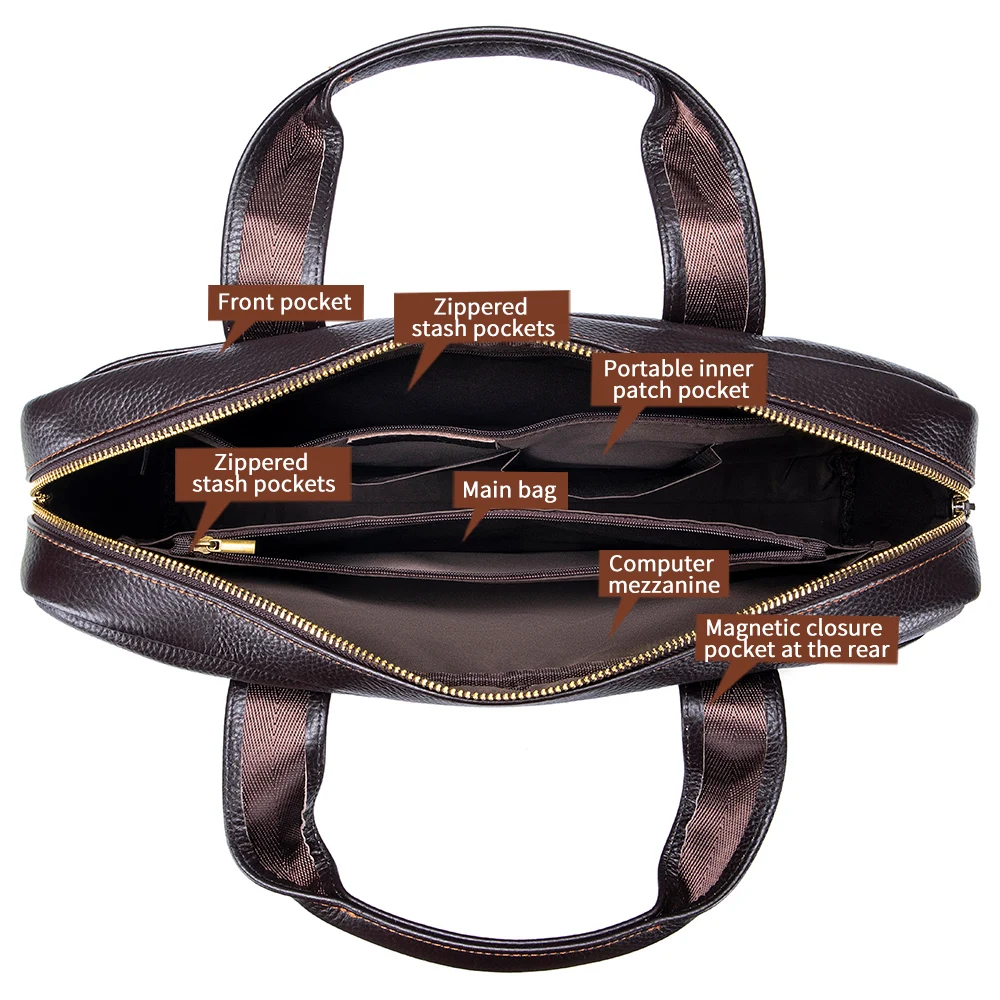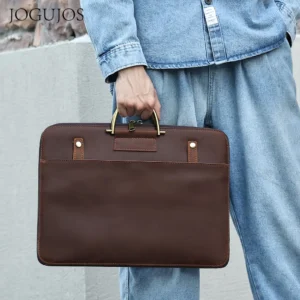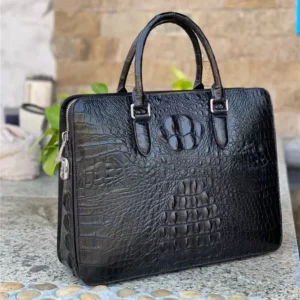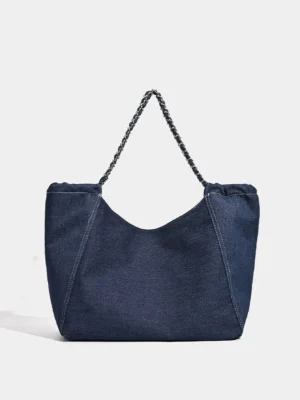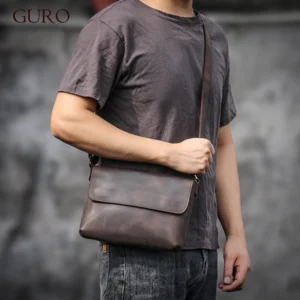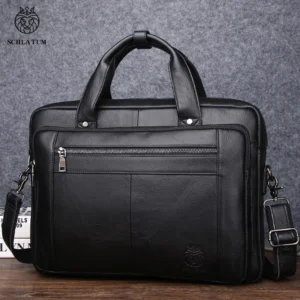Understanding Modern Briefcase Options
The choice between a large or slim briefcase represents more than just a simple accessory decision—it’s about finding the perfect professional companion for your daily journey. Many professionals find themselves standing in front of their wardrobe each morning, questioning whether their current briefcase truly serves their needs or if it’s time for a change.
“Do I need something with more space for client presentations, or would a sleeker option better suit my streamlined workday?”
This common dilemma has become even more relevant as workplace dynamics evolve. With the rise of remote and hybrid work environments, professionals may need different carrying solutions than in traditional office settings. Some days might require transporting multiple devices and documents for important meetings, while others call for just the essentials.
Your briefcase is an extension of your professional identity—a statement about your organizational style, preparation level, and practical priorities. The right choice reflects not just your personal aesthetic but also addresses your functional requirements.
In this comprehensive comparison, we’ll explore the unique advantages and limitations of both large and slim briefcases, helping you determine which style aligns with your professional lifestyle. Understanding the timeless classic leather briefcase options available today can significantly impact your daily comfort and efficiency. We’ll also provide a practical framework for making this decision based on your specific needs rather than passing trends.
Before investing in your next professional companion, it’s worth taking time to consider how to choose the perfect leather briefcase for your unique situation.
Defining Briefcase Dimensions: Large vs. Slim
Before diving into pros and cons, it’s important to establish what actually constitutes “large” versus “slim” in the world of briefcases.
Large Briefcase Typical Dimensions:
- Length: 16-18 inches
- Height: 12-14 inches
- Depth: 5-8 inches
- Weight (empty): 3-5 pounds
- Typical capacity: 15-20 liters
Large briefcases generally accommodate laptops up to 17 inches with room for multiple folders, documents, accessories, and personal items. They often feature expanded depth to create substantial interior volume.
Slim Briefcase Typical Dimensions:
- Length: 15-17 inches
- Height: 11-13 inches
- Depth: 2-4 inches
- Weight (empty): 2-3.5 pounds
- Typical capacity: 8-12 liters
Slim briefcases typically fit laptops up to 15 inches (though some modern designs accommodate larger devices) and offer limited space for essential documents and accessories. Their defining characteristic is a streamlined profile that sits close to the body.
It’s worth noting that terminology can vary between manufacturers. What one brand markets as “slim” might be considered standard by another. When shopping online, always check the specific dimensions rather than relying solely on descriptive terms.
Understanding the perfect briefcase size for work requires considering both the physical measurements and how those dimensions translate to practical capacity. When evaluating options, pay attention to both exterior dimensions and interior organization.
For visual references of current styles, browsing collections of slim leather briefcases can provide a clearer picture of contemporary slim designs.
Large Briefcase Benefits: When More Space Matters
Superior Storage Capacity
The most obvious advantage of a large briefcase is its generous storage capacity. A typical large briefcase can accommodate a 16-inch laptop, power adapter, tablet, several file folders, a water bottle, lunch container, and still have room for personal items like keys, wallet, and phone. This makes it ideal for professionals who need to transport substantial work materials between locations.
Enhanced Organization Systems
Large briefcases often feature more sophisticated organizational systems, including:
* Multiple padded compartments for electronic devices
* Dedicated document sections with dividers
* Specialized pockets for power banks, cables, and adapters
* Pen holders, business card slots, and key leashes
* External quick-access pockets
This comprehensive organization helps maintain order even when carrying numerous items, preventing the frustrating “briefcase dig” to find what you need.
Daily Versatility
The spaciousness of a large briefcase provides flexibility for changing daily requirements. On days with client presentations, you can carry presentation materials and product samples. For overnight business trips, there might be space for a change of clothes and basic toiletries alongside work essentials.
Superior Protection
With more interior space comes additional protection for valuable items. Large briefcases typically offer:
* Enhanced padding around electronic compartments
* Structured sides that resist compression
* Reinforced corners to absorb impact
* Greater distance between items, reducing internal friction and scratching
Professional Presence
In certain professional contexts, a substantial briefcase projects an image of preparedness and authority. It suggests you arrive with all necessary materials and are equipped to handle unexpected situations—an impression particularly valuable in consulting, legal, finance, and senior management roles.
The strategic benefits of large capacity briefcases extend beyond simple storage to include how they position you professionally. For those regularly transporting larger devices, exploring classic laptop briefcase options might provide the ideal balance of protection and professional appearance.
Large Briefcase Drawbacks: When Size Becomes a Burden
While spaciousness offers clear advantages, large briefcases come with several notable drawbacks:
Weight Considerations
Even before adding contents, large briefcases typically weigh more than their slim counterparts. When fully loaded, they can become genuinely heavy, potentially causing:
* Shoulder and back strain during long commutes
* Fatigue when walking between meetings or buildings
* Discomfort when standing for extended periods (like on public transit)
* Physical stress from repeatedly lifting a heavier bag
Mobility Challenges
The bulkier profile of large briefcases can create mobility issues in various situations:
* Difficult to navigate through crowded spaces
* Challenging to position comfortably on public transportation
* May bump against objects or people in tight quarters
* Often requires conscious management in social settings
* Can be unwieldy on stairs or when rushing to catch transportation
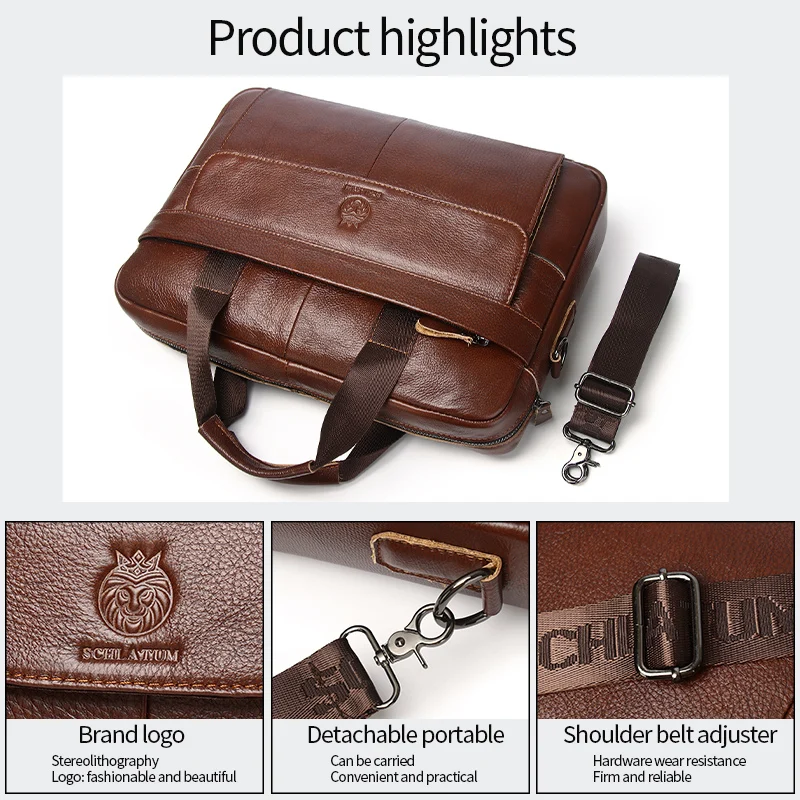
Storage Limitations
Finding appropriate places to store a large briefcase can be problematic:
* May not fit under standard airplane seats
* Takes up significant space in small offices or shared workspaces
* Doesn’t easily tuck beside you in restaurant booths or meeting rooms
* Requires more substantial storage space at home
The Overpacking Temptation
The additional space can actually become a liability by encouraging:
* Carrying unnecessary items “just in case”
* Accumulating papers and documents that could be digitized
* Transporting personal items better left at home or office
* Creating a heavier load than necessary for daily functions
For professionals who need document storage without the bulk of a full briefcase, considering a specialized leather document bag might provide a more focused solution for specific carrying needs.
Slim Briefcase Advantages: The Appeal of Minimalism
Exceptional Portability
The defining advantage of slim briefcases is their outstanding portability:
* Lightweight even when fully loaded
* Easy to carry during longer commutes
* Comfortable to hold close to the body
* Less strain on shoulders and back
* Fits easily through crowded spaces
Modern Professional Aesthetic
Slim briefcases project a contemporary, streamlined image that complements modern professional attire:
* Clean, minimal silhouette
* Less bulky appearance when carried
* Sleek profile that enhances rather than detracts from professional appearance
* Transitions well between formal and business casual environments
* Often perceived as more stylish and current
Beneficial Essentialism
The space constraints of a slim briefcase encourage thoughtful curation of daily items:
* Forces prioritization of truly necessary materials
* Reduces tendency to carry “just in case” items
* Promotes digital organization over paper files
* Creates habits of efficiency and minimalism
* Reduces overall daily carrying weight
Enhanced Maneuverability
The compact form factor provides practical advantages in various professional scenarios:
* Easily slides beside you in meetings without disrupting space
* Fits comfortably under standard airplane seats and in overhead compartments
* Can be placed on your lap when suitable surfaces aren’t available
* Navigates seamlessly through turnstiles and crowded transit
Many commuters find that slim briefcases for daily commute provide the perfect balance of capacity and comfort, especially when traveling on public transportation. For style-conscious professionals, browsing men’s slim leather briefcase options reveals how these streamlined designs complement modern wardrobes.
Slim Briefcase Limitations: When Minimalism Falls Short
Despite their appealing profile, slim briefcases present several practical challenges:
Capacity Restrictions
The defining feature—slimness—creates inherent limitations:
* May only accommodate laptops up to 13-15 inches (though some modern designs fit larger devices)
* Limited space for documents beyond a few key folders
* Often cannot fit bulkier items like water bottles, umbrellas, or lunch containers
* Little room for unexpected additions to your daily carry
Organizational Compromises
With reduced volume comes simplified organization:
* Fewer specialized compartments and pockets
* Limited separation between items
* Potential for items to damage each other when tightly packed
* More difficult to access specific items quickly
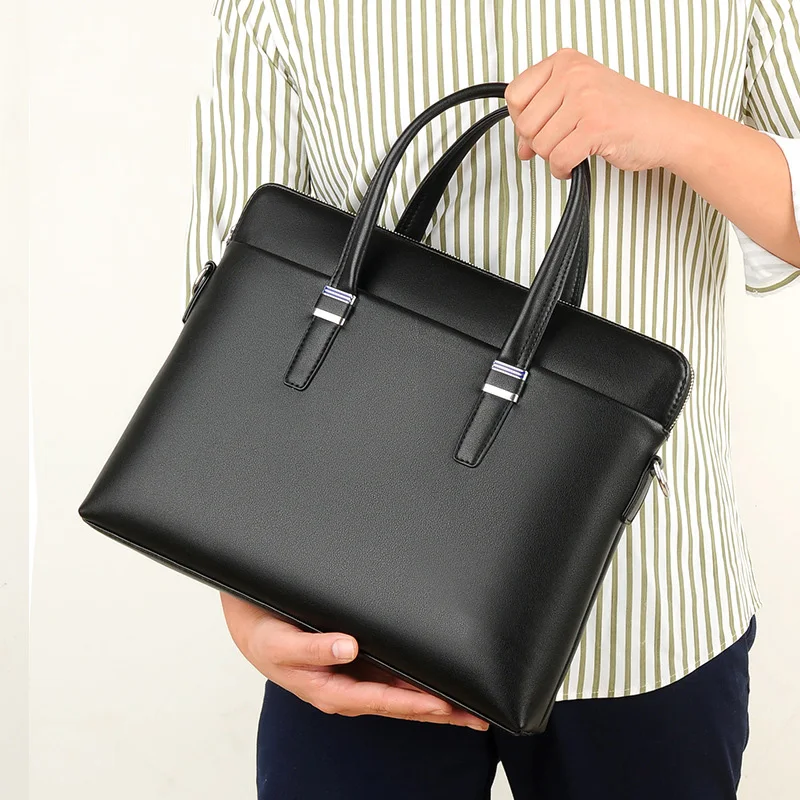
Lack of Adaptability
Slim briefcases offer minimal flexibility for changing needs:
* Cannot easily accommodate project materials for special presentations
* Limited ability to carry personal items alongside work essentials
* Insufficient for days requiring additional technology or reference materials
* May require a separate bag for gym clothes or after-work activities
Overstuffing Issues
The temptation to exceed capacity creates both functional and aesthetic problems:
* Overstuffed slim briefcases lose their sleek appearance
* Closure systems may strain or fail when overpacked
* Items may become damaged when forced into limited space
* The professional image advantage is lost when the briefcase bulges
For a deeper understanding of working within these constraints, exploring the ultimate guide to slim leather briefcases can provide strategies for maximizing limited space.
Head-to-Head Comparison Chart
| Feature | Large Briefcase | Slim Briefcase |
|---|---|---|
| Laptop Size | Up to 17” | Typically up to 15” |
| Document Capacity | Multiple folders, binders | Few folders, limited papers |
| Extra Items | Room for lunch, water bottle, etc. | Limited to essentials only |
| Empty Weight | 3-5 lbs | 2-3.5 lbs |
| Fully Loaded Weight | 8-12+ lbs | 5-7 lbs |
| Public Transit Convenience | ★★☆☆☆ | ★★★★★ |
| Walking Comfort | ★★☆☆☆ | ★★★★☆ |
| Organization Features | ★★★★★ | ★★★☆☆ |
| Professional Image | Authority, preparedness | Efficiency, modernism |
| Adaptability | ★★★★★ | ★★☆☆☆ |
| Price Range | $150-$500+ | $120-$450+ |
This direct comparison highlights the trade-offs between the two styles. For additional context on how different models compare, reviewing classic leather briefcase comparison information can provide specific examples of these differences across brands and designs.
Making Your Decision: Key Factors to Consider
Analyze Your Daily Essentials
Create a list of items you carry every single day, then a secondary list of occasional items. Be honest about what’s truly essential versus what’s convenient. This simple exercise often reveals whether you need the extra space of a large briefcase or could function well with a slim design.Evaluate Your Commute Reality
Consider your typical transportation method:
* Long walking distances favor lighter, slim options
* Driving commuters may find large briefcases less problematic
* Public transportation users often benefit from slim designs in crowded conditions
* Bicycle or scooter commuters might prefer the stability of a compact profileAssess Your Professional Environment
Different workplace cultures and roles have varying requirements:
* Client-facing positions often need materials for presentations
* Executive roles might benefit from having reference materials available
* Creative professionals frequently transport specialized equipment
* Technical roles may require multiple devices or documentationConsider Physical Comfort
Be realistic about your comfort carrying different weights:
* Pre-existing back or shoulder issues suggest opting for slim designs
* Your physical build may make certain weights more manageable
* Consider whether you’ll regularly carry the briefcase for extended periods
Choosing the perfect briefcase size for work ultimately comes down to your individual requirements and preferences. The ideal choice balances professional image, practical function, and personal comfort.
Beyond Size: Quality Considerations for Any Briefcase
Regardless of which size you select, certain quality elements determine whether your investment will provide lasting value:
Material Quality
The primary material significantly impacts durability, appearance, and maintenance:
* Full-grain leather develops a rich patina over time but requires regular conditioning
* Top-grain leather offers good durability with less maintenance
* Ballistic nylon provides exceptional strength and water resistance
* Waxed canvas offers a casual aesthetic with good weather protection
Construction Elements
Look closely at how the briefcase is constructed:
* Stitching should be tight, even, and reinforced at stress points
* Hardware (buckles, zippers, clasps) should operate smoothly and feel substantial
* Interior lining should be firmly attached and made from durable materials
* Handles and straps should be securely anchored to the body of the briefcase
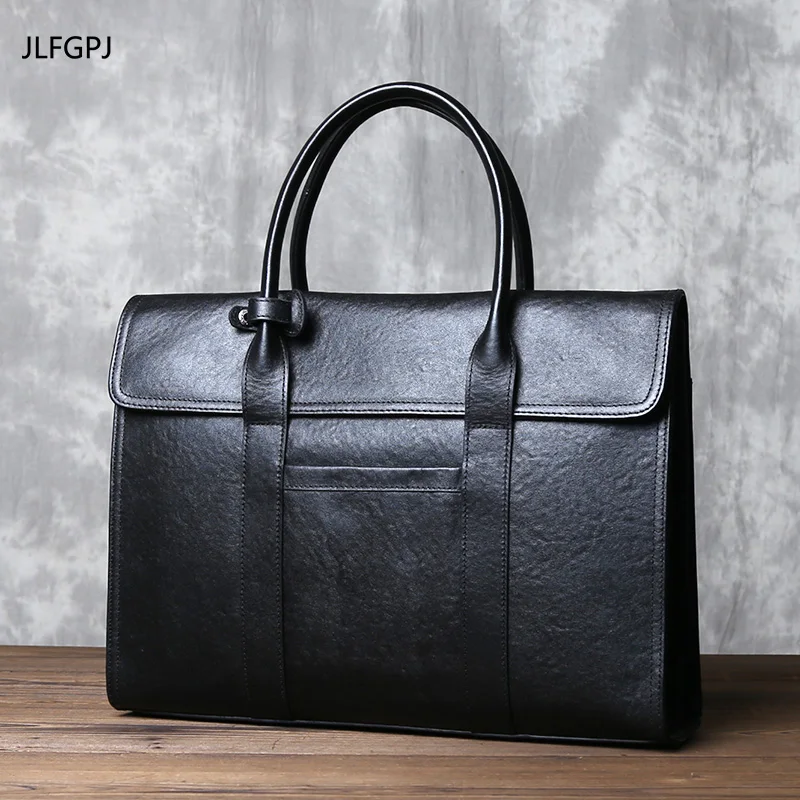
Organizational Intelligence
Thoughtful organization enhances functionality regardless of size:
* Padded laptop compartments with secure closure
* Easily accessible pockets for frequently used items
* Pen loops and card holders that don’t intrude on main storage
* Logical placement of compartments based on item access frequency
Understanding what makes the best leather briefcases starts with recognizing these quality indicators across both size categories.
Finding Middle Ground: Expandable Briefcase Options
For professionals struggling to choose between large and slim options, expandable briefcases offer an appealing compromise:
- Feature expansion zippers or gussets that increase depth when needed
- Provide a slim profile for daily essentials but adapt for occasional larger loads
- Allow transition between different professional scenarios without multiple bags
- Offer “best of both worlds” flexibility for varying requirements
The expandability feature typically adds slight weight and cost but delivers significant versatility benefits. These designs work well for professionals with variable carrying needs throughout the week.
Some professionals find that leather messenger bags provide similar flexibility with a slightly different aesthetic, offering expandable capacity in a less formal silhouette.
Men's Classic Leather Briefcase, Slim Leather Laptop Briefcase, Slim Leather Portfolio Briefcase
$93.67 Select options This product has multiple variants. The options may be chosen on the product pageClassic Laptop Briefcase, Men's Classic Leather Briefcase, Slim Leather Attache Case
Price range: $353.50 through $360.81 Select options This product has multiple variants. The options may be chosen on the product pageBlack Leather Briefcase, Leather Document Bag, Men's Classic Leather Briefcase
Genuine Crocodile Leather Executive Briefcase with Password Lock – Premium Business Document Carrier$1,201.87 Select options This product has multiple variants. The options may be chosen on the product pageCanvas & Leather Messenger Bag, Leather Commuter Tote
$80.41 Select options This product has multiple variants. The options may be chosen on the product pageCrazy Horse Leather Satchel, Men's Leather Satchel, Men's Professional Leather Messenger, Vintage Style Messenger Bag
$132.70 Select options This product has multiple variants. The options may be chosen on the product pageBlack Leather Briefcase, Classic Laptop Briefcase, Men's Classic Leather Briefcase, Slim Leather Laptop Briefcase
$228.72 Select options This product has multiple variants. The options may be chosen on the product page
Frequently Asked Questions About Briefcase Sizing
Can a slim briefcase accommodate a water bottle or umbrella?
Most standard slim briefcases cannot comfortably fit these items internally. Some feature external attachment points or small exterior pockets that might accommodate compact versions. For regular water bottle or umbrella carry, consider either a large briefcase or a slim model with dedicated external storage.
Are large briefcases always heavier, even when empty?
Generally yes, though the difference varies by material and construction. The additional structure and hardware required for larger designs typically add 1-2 pounds even when empty. However, high-quality lightweight materials can sometimes make a well-designed large briefcase comparable in weight to a poorly designed slim one.
How do I measure my laptop to ensure it fits properly?
Measure diagonally from screen corner to screen corner (excluding the frame) to determine the display size. Then measure the closed laptop’s width, height, and depth to compare with the briefcase’s laptop compartment dimensions. Allow at least half an inch of extra space in each dimension for easy insertion and removal.
Is one style more professional than the other in formal settings?
Neither style is inherently more or less professional. What matters is the quality, condition, and appropriateness for your specific role and environment. In traditional fields like law or finance, large briefcases remain common, while in technology or creative industries, slim designs often predominate.
Understanding the best size briefcase for your specific needs requires balancing these practical considerations with your professional environment.
Final Considerations: Making Your Investment Last
Whichever style you choose, maximize the return on your investment by considering these factors:
Regular Maintenance: Establish a simple routine based on your briefcase’s material—whether conditioning leather, spot-cleaning fabric, or checking hardware for issues.
Storage Practices: Store your briefcase properly when not in use—stuffed with paper to maintain shape, away from direct sunlight, and in a dust bag if provided.
Load Management: Respect weight limitations even with large briefcases; excessive weight strains seams, handles, and hardware regardless of capacity.
Adaptation Strategies: Consider complementary accessories like laptop sleeves or document folios that can transition between different bags as needs change.
Remember that the perfect briefcase is one that serves your specific needs while providing comfort and confidence in professional settings. The right choice enhances your efficiency rather than complicating it.
For those prioritizing longevity, exploring durable leather briefcase options can help identify construction features that contribute to extended usability across both size categories.
At Poise Porter, we believe your briefcase should be a reliable partner in your professional journey, regardless of which size best suits your unique needs.

